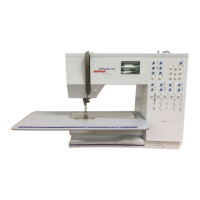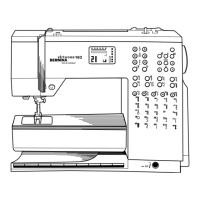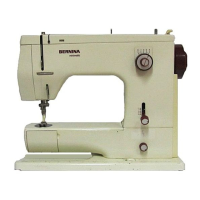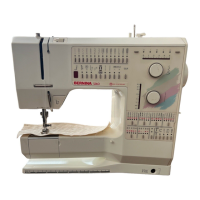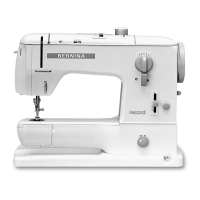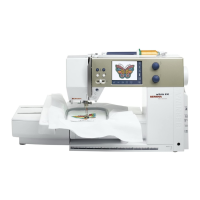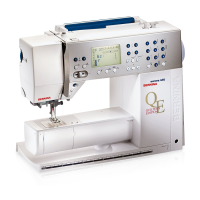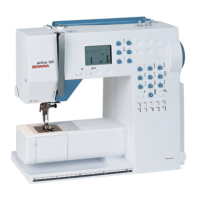Do you have a question about the Bernina virtuosa 153 and is the answer not in the manual?
Protects machine from dust and dirt; compartment for accessories.
Lists standard accessories like foot control, manual, power cable, etc.
Details standard accessories like bobbins, needles, seam ripper, and tools.
Step-by-step guide on how to wind a bobbin using the bobbin winder.
Instructions for removing and inserting the bobbin case correctly.
Procedure for removing and inserting the sewing machine needle.
Steps for attaching and removing different presser feet.
Detailed steps for guiding the upper thread through the machine.
Instructions on how to operate the automatic needle threader.
Explanation of the markings on the stitch plate for guidance.
How to adjust thread tension for different fabrics and threads.
Explanation of the icons and information shown on the sewing computer screen.
How to select and adjust stitch width, length, and needle position.
Using reverse, securing, and memory functions for stitching.
Overview of buttonhole types and preparation steps using buttonhole feet.
Instructions for sewing manual buttonholes, step-by-step.
Step-by-step guide for sewing manual keyhole buttonholes.
How to sew automatic standard and stretch buttonholes with auto length.
Saving programmed buttonholes in memory and recalling them for reuse.
How to adjust balance for stitch counter and manual buttonholes.
Understanding the memory screen display and selecting stitches.
Storing letters and numbers in the machine's memory.
Saving practical and decorative stitches into the machine's memory.
Saving letters and numbers into the machine's memory.
Balancing forward/reverse stitches and fine stitch length adjustments.
Adjusting presser foot pressure for different fabric types.
List and descriptions of practical and decorative stitches for Virtuosa 153 QE.
List and descriptions of practical and decorative stitches for Virtuosa 163.
Details for stitches 1-3: Straight, Zig-zag, and Vari-overlock stitches.
Details for stitches 4-6: Running, Securing, and Triple Zig-zag stitches.
Details for stitches 1-3: Straight, Zig-zag, and Vari-overlock stitches.
Details for stitches 4-6: Running, Securing, and Triple Zig-zag stitches.
Overview of standard presser feet like Reverse, Overlock, Buttonhole, and Zipper feet.
Introduction to special purpose-designed presser feet for specific tasks.
Guidance on selecting the correct needle type based on thread and fabric.
How stitch length affects feed-dog movement and fabric feeding.
Techniques for correcting fabric feeding issues using compensating plates.
Instructions for cleaning the machine after use and cleaning the hook assembly.
Guide for replacing the sewing light bulb.
Diagnosing and fixing problems with thread breaks and skipped stitches.
Troubleshooting needle breaks and machine operational failures.
How to select, adjust stitch length, and change needle position for straight stitch.
Using the quick reverse button to secure seams at the beginning and end.
Methods for narrow and wide edge stitching using different presser feet.
Using the seam guide for precise parallel stitching along edges.
Selecting and adjusting stitch width and length for zig-zag stitch.
Using dense zig-zag for satin stitch and oversewing fabric edges.
How to select and alter stitch width and length for decorative stitches.
Tips for using stabilizer when sewing decorative stitches on single fabric.
Examples of programming stitch combinations and individual stitches.
Tips for stitch combinations on double and single fabric layers.
How to program names, initials, and years using machine memory.
Creating open seams using straight, zig-zag, and super stretch stitches.
Sewing closed seams using vari-overlock and double overlock stitches.
Creating strong seams for heavy fabrics using triple straight stitch.
Sewing flexible seams for stretchy fabrics using super stretch stitch.
Sewing stretchy seams in fine knits using the vari-overlock stitch.
Creating overlock seams in loose knits and cross seams.
Sewing stretch overlock seams in coarse or loose knits.
Creating flat, durable seams by overlapping and over-sewing fabric edges.
Sewing visible stretch hems on knit fabrics using jersey stitch.
Creating strong, visible hems on dense fabrics with triple zig-zag.
Tips on needles, thread, sewing tests, and presser foot pressure for knits.
Creating a self-facing hem using the honeycomb stitch.
Applying ribbing to knit openings using an overlock seam.
Step-by-step guide for sewing zippers using Zipper foot No. 4.
Advice on sewing around zipper pulls and handling thick fabrics.
How to sew invisible hems using Blind stitch foot No. 5.
Adjusting stitch width for precise blind hemming.
Using Universal stitch to sew narrow elastic for gathering and finishing.
Applying shirring elastic or cord using the gathering stitch.
Methods for marking buttonhole lengths for manual and automatic types.
Adjusting stitch width, length, and balance for buttonholes.
Selecting, preparing, and testing manual buttonholes.
Step-by-step guide for sewing a standard manual buttonhole.
How the automatic buttonhole foot registers length for exact duplication.
Steps for sewing and programming automatic buttonholes.
Selecting, sewing, and correcting stitch counter buttonholes.
Advice on speed, marking, and using presser foot No. 3 for buttonholes.
Reinforcing and enhancing buttonholes with gimp cord using different feet.
How to sew eyelets for decorative work, cords, and ribbons.
Using an eyelet punch to open sewn eyelets.
Creating a hand-sewn look with the quilt stitch, including tension and balance.
Using the patchwork foot for accurate 1/4" seam allowances.
Techniques for freehand quilting and stipple quilting designs.
Advice on thread breaks, stitch formation, and monofilament thread for darning.
Using shirring elastic with zig-zag stitch to edge knit fabrics.
Reinforcing edges and applying patches to woven fabrics.
Disguising worn areas on stretchy fabrics with patches.
Using running stitch for quick repairs on tears and worn fabric areas.
Using Reverse Pattern foot or Buttonhole foot for quick darning.
Correcting darning programs and using reinforcement.
Step-by-step method for darning flat and tubular areas manually.
Protects machine from dust and dirt; compartment for accessories.
Lists standard accessories like foot control, manual, power cable, etc.
Details standard accessories like bobbins, needles, seam ripper, and tools.
Step-by-step guide on how to wind a bobbin using the bobbin winder.
Instructions for removing and inserting the bobbin case correctly.
Procedure for removing and inserting the sewing machine needle.
Steps for attaching and removing different presser feet.
Detailed steps for guiding the upper thread through the machine.
Instructions on how to operate the automatic needle threader.
Explanation of the markings on the stitch plate for guidance.
How to adjust thread tension for different fabrics and threads.
Explanation of the icons and information shown on the sewing computer screen.
How to select and adjust stitch width, length, and needle position.
Using reverse, securing, and memory functions for stitching.
Overview of buttonhole types and preparation steps using buttonhole feet.
Instructions for sewing manual buttonholes, step-by-step.
Step-by-step guide for sewing manual keyhole buttonholes.
How to sew automatic standard and stretch buttonholes with auto length.
Saving programmed buttonholes in memory and recalling them for reuse.
How to adjust balance for stitch counter and manual buttonholes.
Understanding the memory screen display and selecting stitches.
Storing letters and numbers in the machine's memory.
Saving practical and decorative stitches into the machine's memory.
Saving letters and numbers into the machine's memory.
Balancing forward/reverse stitches and fine stitch length adjustments.
Adjusting presser foot pressure for different fabric types.
List and descriptions of practical and decorative stitches for Virtuosa 153 QE.
List and descriptions of practical and decorative stitches for Virtuosa 163.
Details for stitches 1-3: Straight, Zig-zag, and Vari-overlock stitches.
Details for stitches 4-6: Running, Securing, and Triple Zig-zag stitches.
Details for stitches 1-3: Straight, Zig-zag, and Vari-overlock stitches.
Details for stitches 4-6: Running, Securing, and Triple Zig-zag stitches.
Overview of standard presser feet like Reverse, Overlock, Buttonhole, and Zipper feet.
Introduction to special purpose-designed presser feet for specific tasks.
Guidance on selecting the correct needle type based on thread and fabric.
How stitch length affects feed-dog movement and fabric feeding.
Techniques for correcting fabric feeding issues using compensating plates.
Instructions for cleaning the machine after use and cleaning the hook assembly.
Guide for replacing the sewing light bulb.
Diagnosing and fixing problems with thread breaks and skipped stitches.
Troubleshooting needle breaks and machine operational failures.
How to select, adjust stitch length, and change needle position for straight stitch.
Using the quick reverse button to secure seams at the beginning and end.
Methods for narrow and wide edge stitching using different presser feet.
Using the seam guide for precise parallel stitching along edges.
Selecting and adjusting stitch width and length for zig-zag stitch.
Using dense zig-zag for satin stitch and oversewing fabric edges.
How to select and alter stitch width and length for decorative stitches.
Tips for using stabilizer when sewing decorative stitches on single fabric.
Examples of programming stitch combinations and individual stitches.
Tips for stitch combinations on double and single fabric layers.
How to program names, initials, and years using machine memory.
Creating open seams using straight, zig-zag, and super stretch stitches.
Sewing closed seams using vari-overlock and double overlock stitches.
Creating strong seams for heavy fabrics using triple straight stitch.
Sewing flexible seams for stretchy fabrics using super stretch stitch.
Sewing stretchy seams in fine knits using the vari-overlock stitch.
Creating overlock seams in loose knits and cross seams.
Sewing stretch overlock seams in coarse or loose knits.
Creating flat, durable seams by overlapping and over-sewing fabric edges.
Sewing visible stretch hems on knit fabrics using jersey stitch.
Creating strong, visible hems on dense fabrics with triple zig-zag.
Tips on needles, thread, sewing tests, and presser foot pressure for knits.
Creating a self-facing hem using the honeycomb stitch.
Applying ribbing to knit openings using an overlock seam.
Step-by-step guide for sewing zippers using Zipper foot No. 4.
Advice on sewing around zipper pulls and handling thick fabrics.
How to sew invisible hems using Blind stitch foot No. 5.
Adjusting stitch width for precise blind hemming.
Using Universal stitch to sew narrow elastic for gathering and finishing.
Applying shirring elastic or cord using the gathering stitch.
Methods for marking buttonhole lengths for manual and automatic types.
Adjusting stitch width, length, and balance for buttonholes.
Selecting, preparing, and testing manual buttonholes.
Step-by-step guide for sewing a standard manual buttonhole.
How the automatic buttonhole foot registers length for exact duplication.
Steps for sewing and programming automatic buttonholes.
Selecting, sewing, and correcting stitch counter buttonholes.
Advice on speed, marking, and using presser foot No. 3 for buttonholes.
Reinforcing and enhancing buttonholes with gimp cord using different feet.
How to sew eyelets for decorative work, cords, and ribbons.
Using an eyelet punch to open sewn eyelets.
Creating a hand-sewn look with the quilt stitch, including tension and balance.
Using the patchwork foot for accurate 1/4" seam allowances.
Techniques for freehand quilting and stipple quilting designs.
Advice on thread breaks, stitch formation, and monofilament thread for darning.
Using shirring elastic with zig-zag stitch to edge knit fabrics.
Reinforcing edges and applying patches to woven fabrics.
Disguising worn areas on stretchy fabrics with patches.
Using running stitch for quick repairs on tears and worn fabric areas.
Using Reverse Pattern foot or Buttonhole foot for quick darning.
Correcting darning programs and using reinforcement.
Step-by-step method for darning flat and tubular areas manually.
| Stitch Width | 5.5 mm |
|---|---|
| Stitch Length | 5 mm |
| Sewing Speed | 900 stitches per minute |
| Hook System | CB Hook |
| Free Arm | Yes |
| Display | LCD |
| Type | Electronic |
| Automatic Needle Threader | Yes |
| Speed Control | Yes |
